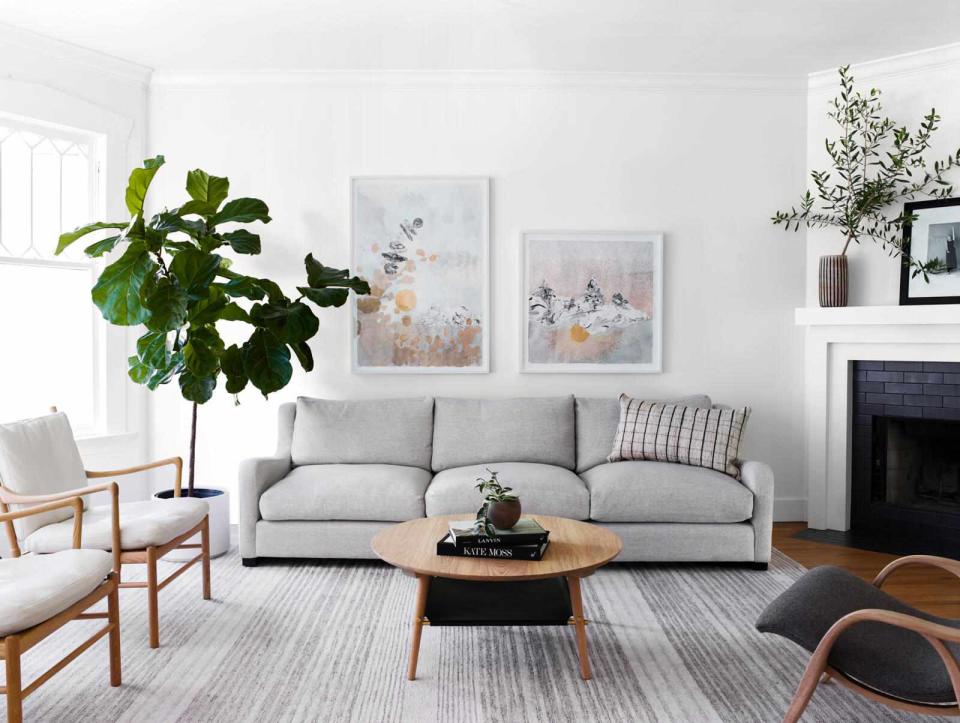7 Elements That Make a Home Charming and Cozy
Want a home that's comfortable? Try these tips.

Design by Kristen Peña / Courtesy R. Brad. Knipstein
What creates an inviting space? Kristen Peña, interior designer and owner of K Interiors, has pinpointed the essential design choices that add charm and coziness. She walked us through one of of her projects in San Francisco to show how easily it can be done. Try these tips to create a home that's charming and comfortable.
Related:8 Easy Ways to Cozy Up Your Home
Balanced Tones
Make a cool, monochromatic space more comfortable by adding warm tones. In a room decorated primarily with blues and grays, for example, Peña suggests incorporating wood accents or artwork featuring an earthy yellow shade to create a more relaxed feel. The opposing tones complement each other to achieve a well-rounded look.
Greenery
Plants are a must-have in all of Peña’s designs. “They can help fill space at a lower cost than furniture,” she says. They also create a sense of calm and continuity with your exterior surroundings. Her current go-to greenery is Ficus Moclame, which she says provides an organic and architectural focal point. When it comes to picking the right container, look around the room. If the space is minimalist, choose a pot with a basket weave or texture that adds interest. It’s all about finding balance among the elements in each space.

Design by Kristen Peña / Courtesy R. Brad Knipstein
Texture
In a neutral room without much color, “texture adds warmth,” says Peña. Choose at least three varied materials (like linen, leather, macramé, and wood grain) to make a room cozy and inviting. Texture is particularly impactful in a bedroom, where you don’t want too many distracting colors or patterns but still want the space to feel luxe and layered.
Adjustable Art
“Leaning your artwork is less of a commitment than nailing a hole in the wall” and allows for more flexibility, says Peña. Cluster an assortment of sizes and swap out prints as the season or your mood changes. If your art is bold and varied, keep the frames sleek and similar, but if it’s cohesive in color and style, use a variety of frames.
Wallpaper
If your space has architectural detailing like wainscoting or a chair rail, a bit of pattern on the strip of wall above it can add “substantial drama without a huge investment,” says Peña. Plus, wallpaper can be helpful when molding or built-ins create a small or oddly shaped wall with no obvious place to hang art. Use it in a dining room or half bath for a striking surprise.

Design by Kristen Peña / Courtesy R. Brad Knipstein
Paint
A consistent palette creates flow throughout the house. You don’t have to use the same color in every room, but choose similar shades like warm gray in the living room with warm white in the kitchen. In more secluded areas, make bolder paint choices to add character, but stick with complementary shades. Above, a rich blue (Benjamin Moore Century in Delft) makes the light-filled space feel restful and cozy.
Curves
If you walk into a room and something feels “off,” look around to see if there are too many angular elements. Adding rounded pieces, such as mirrors, light fixtures, or curved-back chairs, will make the room instantly more soft and inviting.
For more Real Simple news, make sure to sign up for our newsletter!
Read the original article on Real Simple.

